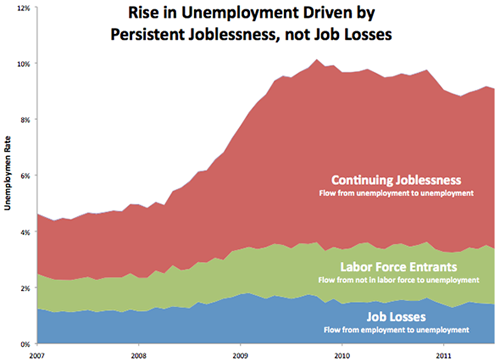Sometimes it's useful to look at something in a different way -- maybe you'll shake loose a new idea.
The picture below breaks the unemployment rate down into three flows into joblessness:
- Employment to unemployment: lose your job, start looking for a new one;

Source: BLS
Unsurprisingly, the largest contributor to the overall rate is unemp-to-unemp. The lack of job creation has meant millions stuck in long-term unemployment. In the last employment report, 44% of the 14 million unemployed had been seeking work for at least half-a-year.
Flows from job losses into unemployment have been pretty steady. This is consistent with other evidence that our problem is not coming from layoffs as much as from weak job growth.
There has been a little bump up in the flow from out-of-the-labor-force to unemployment. It's small, so don't want to read too much into it, but it's important, because the share of the population in the labor force -- either working or looking for work -- is way down, as lots of folks have given up looking in such a weak job market. If they start coming back, and presumably, many can only stay out for so long, that part of the mountain will grow, and that means we'll need more jobs to get the overall rate down.
So, what are the policy implications of this?
Clearly, we need to lower the budget deficit and cut, cut, cut!! Kidding... sorry... gallows humor.
The big non-flow component -- unemp-to-unemp -- implies the need to extend Unemployment Insurance benefits for at least another year.
The possibility that more folks are entering the workforce and falling right into unemployment, along with the big red chunk just discussed suggests that maybe a new jobs tax credit could be helpful right now.
The idea here is to give employers a tax credit when they hire a new worker, as opposed to the much broader approach of something like a payroll tax credit (which is a credit for all employees, new and old). The new jobs credit is designed to give those employers considering a new hire an incentive to pull the trigger.
Of course, the credit won't help much if demand is so weak that employers simply won't hire, even if we make it cheaper for them. Here again, more direct hiring programs, like FAST! can help. Also, UI benefits have a relatively large multiplier, so you actually scratch of couple of itches by extending those benefits.
For the record, I'm well aware that this is all very analytical and logical in a world that is not particularly welcoming to such logic right now. But I plan to continue calmly proceeding down the eightfold path of enlightenment, asking others to join me along the way. It's the best plan I know.
This post originally appeared at Jared Bernstein's On The Economy blog.
